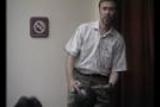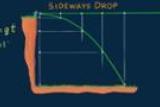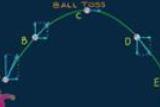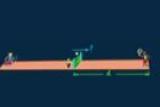Conceptual Physics
Chapter 10: Projectile and Satellite Motion
- 2x
- 1.75x
- 1.5x
- 1.25x
- 1x, selected
- 0.75x
- 0.5x
- Chapters
- descriptions off, selected
- captions settings, opens captions settings dialog
- captions off, selected
This is a modal window.
Beginning of dialog window. Escape will cancel and close the window.
End of dialog window.
This is a modal window. This modal can be closed by pressing the Escape key or activating the close button.
This is a modal window.
An object in free fall moving sideways is affected by the force of gravity just as if it were not moving sideways. Downward acceleration and sideways motion together results in a curved fall. Duration: 6:52.
- 2x
- 1.75x
- 1.5x
- 1.25x
- 1x, selected
- 0.75x
- 0.5x
- Chapters
- descriptions off, selected
- captions settings, opens captions settings dialog
- captions off, selected
This is a modal window.
Beginning of dialog window. Escape will cancel and close the window.
End of dialog window.
This is a modal window. This modal can be closed by pressing the Escape key or activating the close button.
This is a modal window.
Bullseye Bob drops a bullet while firing another horizontally, then analyzed in Paul's televised classroom, followed up with vertical and horizontal motion independence. Duration: 9:15.
- 2x
- 1.75x
- 1.5x
- 1.25x
- 1x, selected
- 0.75x
- 0.5x
- Chapters
- descriptions off, selected
- captions settings, opens captions settings dialog
- captions off, selected
This is a modal window.
Beginning of dialog window. Escape will cancel and close the window.
End of dialog window.
This is a modal window. This modal can be closed by pressing the Escape key or activating the close button.
This is a modal window.
Paul shows how the motion of a ball tossed by Phil Physiker can be carefully analyzed, with interesting distinctions.
- 2x
- 1.75x
- 1.5x
- 1.25x
- 1x, selected
- 0.75x
- 0.5x
- Chapters
- descriptions off, selected
- captions settings, opens captions settings dialog
- captions off, selected
This is a modal window.
Beginning of dialog window. Escape will cancel and close the window.
End of dialog window.
This is a modal window. This modal can be closed by pressing the Escape key or activating the close button.
This is a modal window.
Paul shows the solution to finding the maximum velocity of a horizontally-moving tennis ball that barely clears the net to remain in the court. Duration: 3:46.
Watch these additional videos to complete this tutorial.
Table of Videos
- Chapter 1: About Science
- Chapter 2: Newton's First Law
- Chapter 3: Linear Motion
- Chapter 4: Newton's Second Law
- Chapter 5: Newton's Third Law
- Chapter 6: Momentum
- Chapter 7: Energy
- Chapter 8: Rotational Motion
- Chapter 9: Gravity
- Chapter 10: Projectile and Satellite Motion
- Chapter 11: The Atomic Nature of Matter
- Chapter 12: Solids
- Chapter 13: Liquids
- Chapter 14: Gases
- Chapter 15: Temp, Heat, and Expansion
- Chapter 16: Heat Transfer
- Chapter 17: Change of Phase
- Chapter 18: Thermodynamics
- Chapter 19: Vibrations and Waves
- Chapter 20: Sound
- Chapter 21: Musical Sounds
- Chapter 22: Electrostatics
- Chapter 23: Electric Current
- Chapter 24: Magnetism
- Chapter 25: Electromagnetic Induction
- Chapter 26: Properties of Light
- Chapter 27: Color
- Chapter 28: Reflection and Refraction
- Chapter 29: Light Waves
- Chapter 30: Light Emission
- Chapter 31: Light Quanta
- Chapter 32: The Atom and the Quantum
- Chapter 33: The Atomic Nucleus
- Chapter 34: Nuclear Fission and Fusion
- Chapter 35: Special Theory of Relativity
- Chapter 36: General Theory of Relativity




